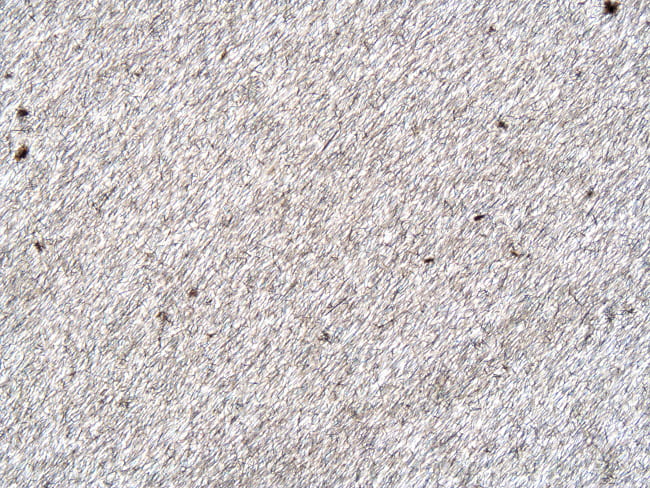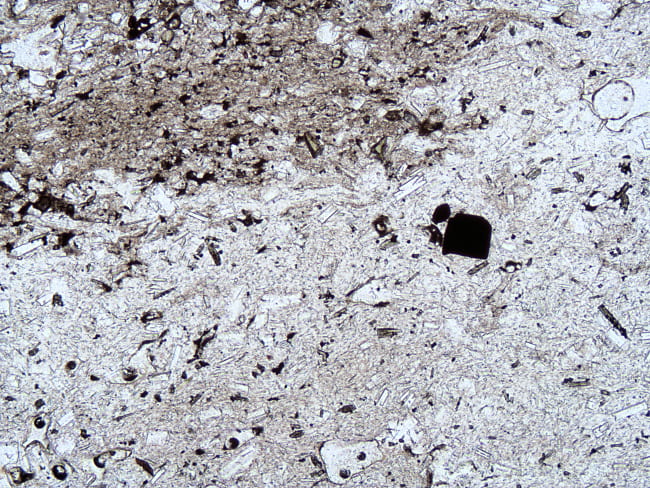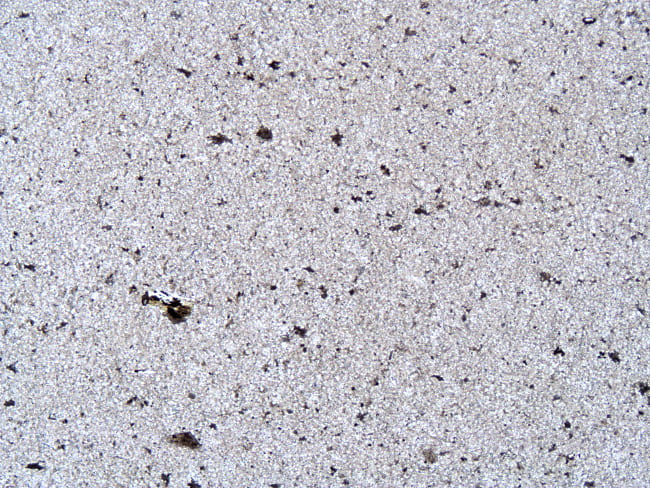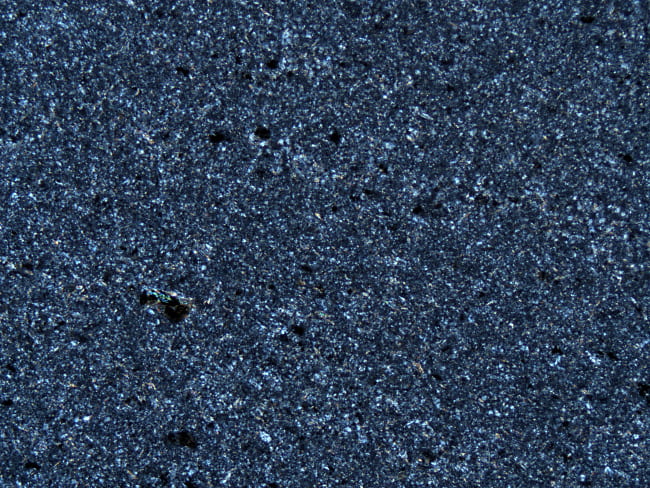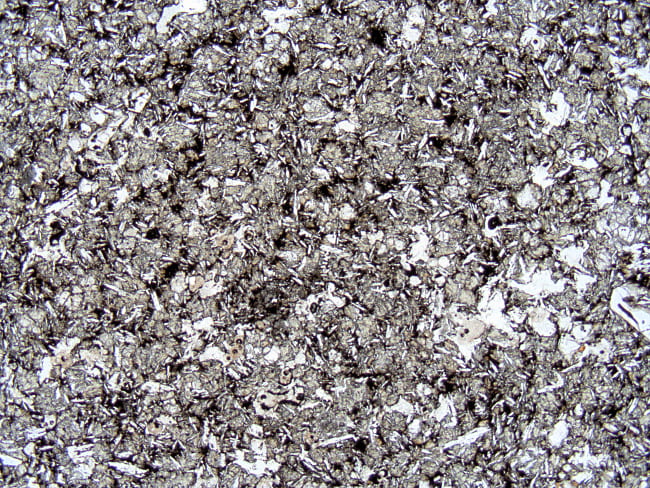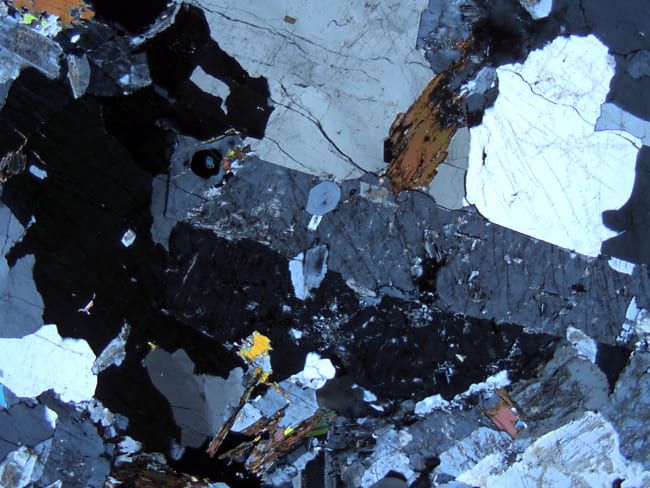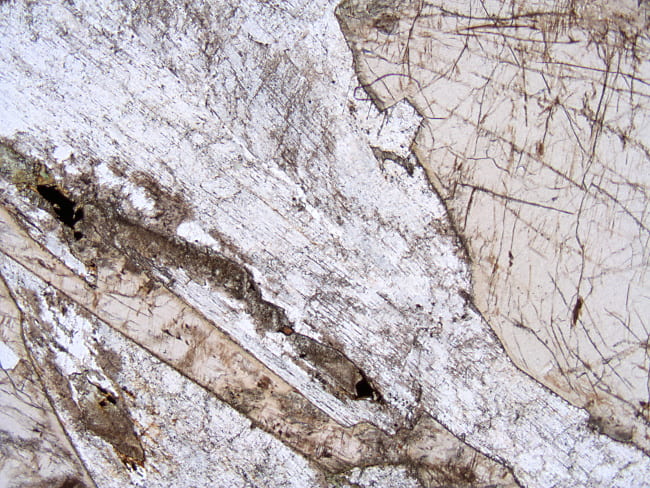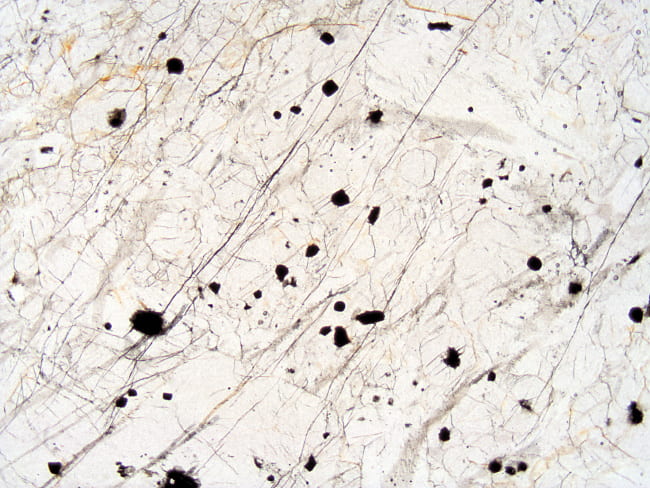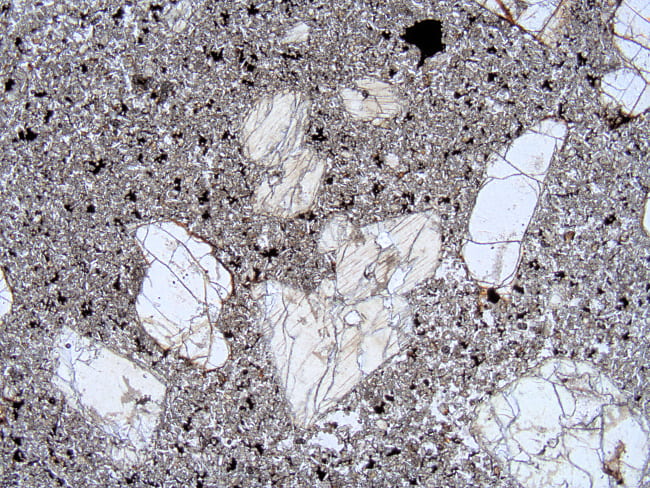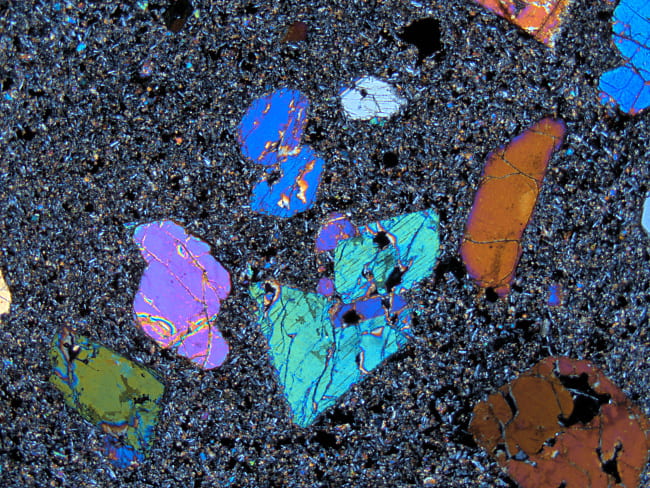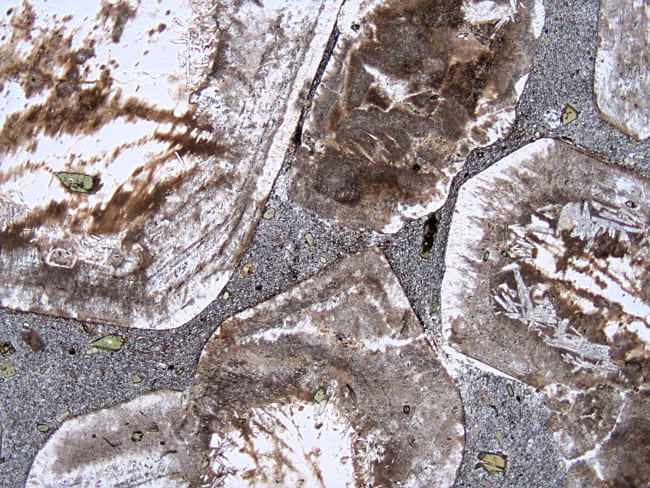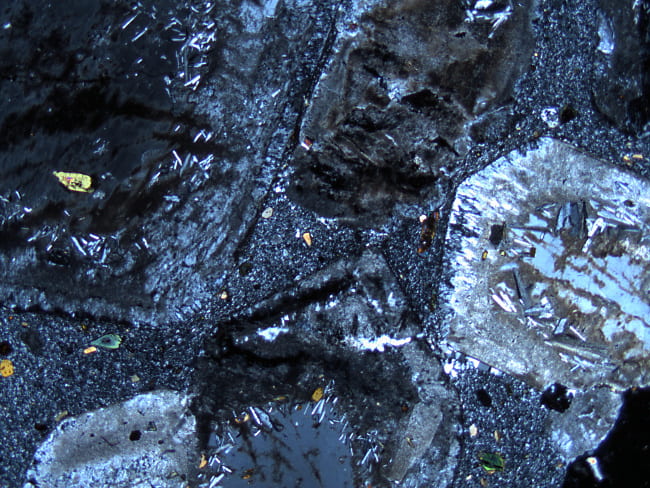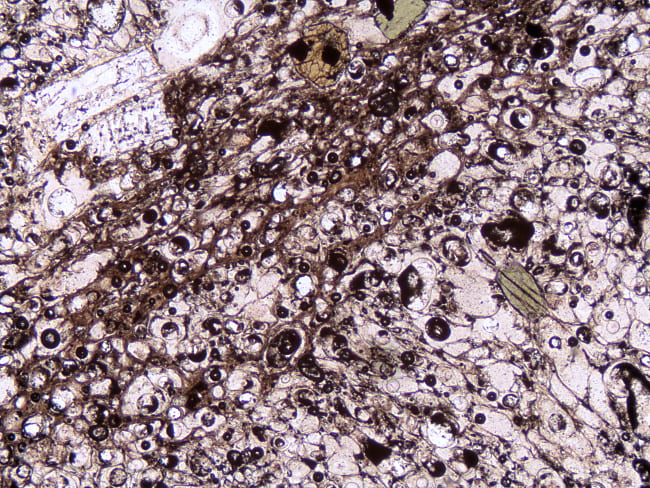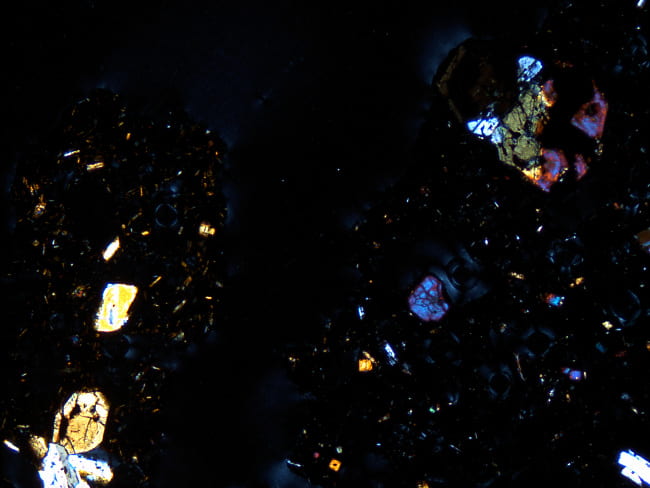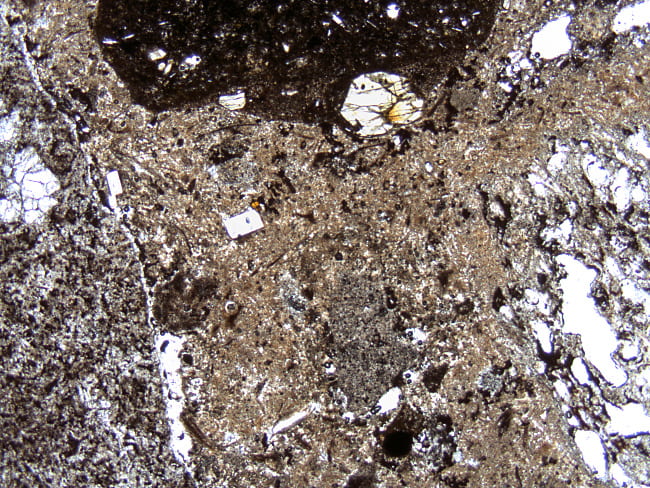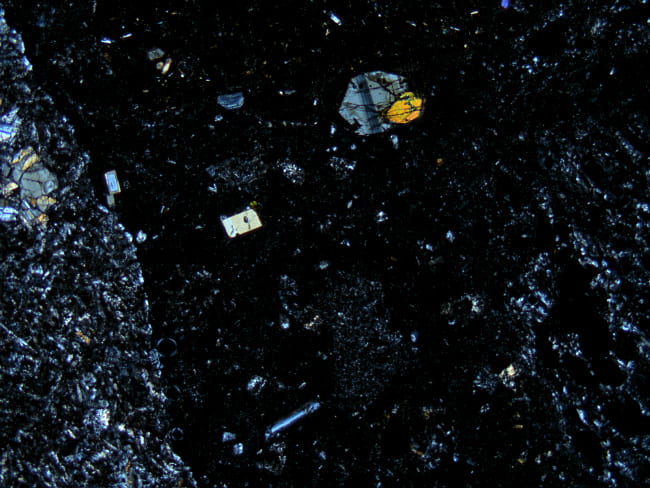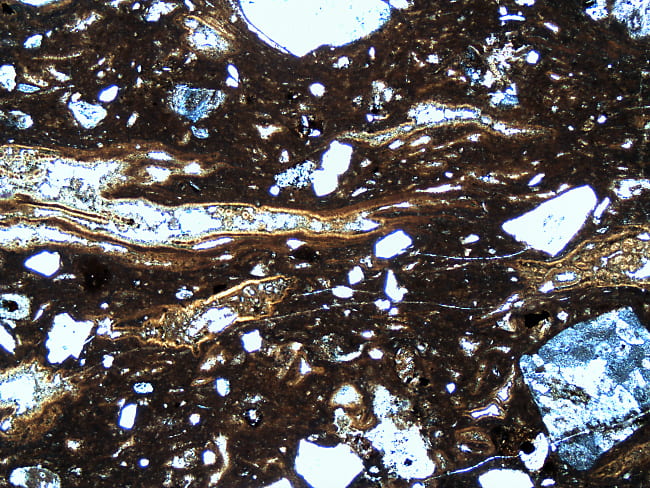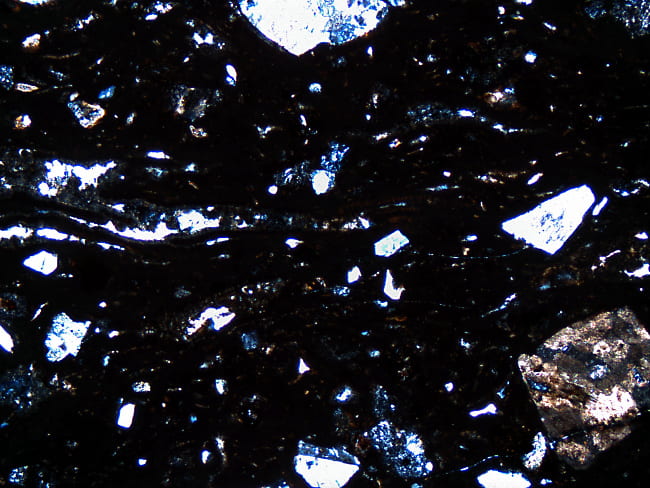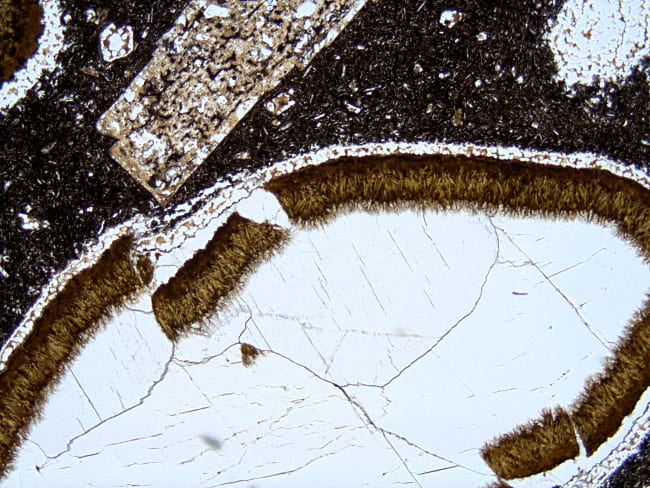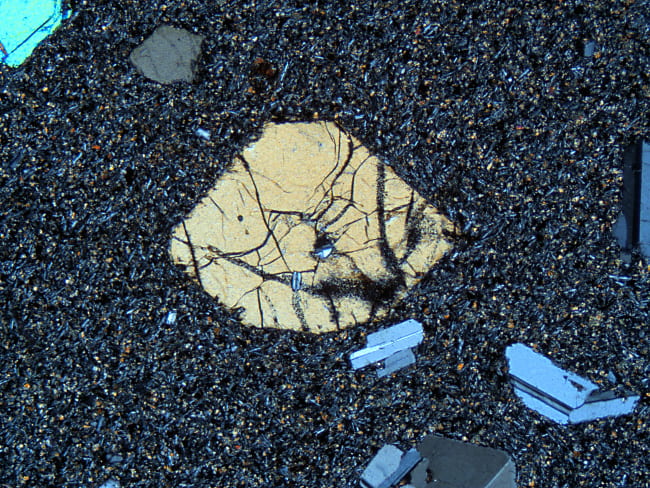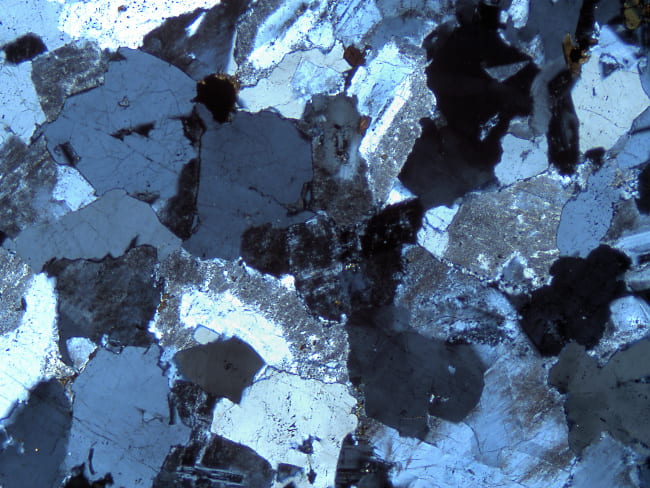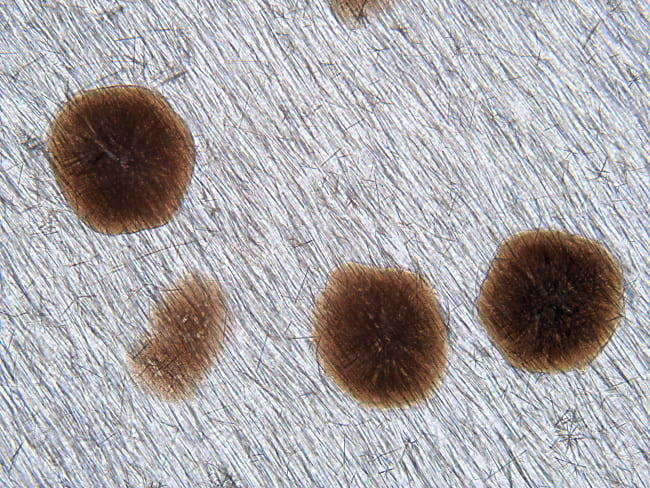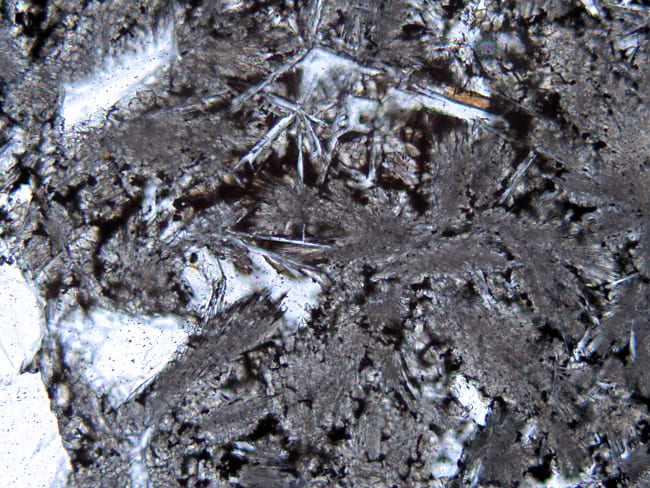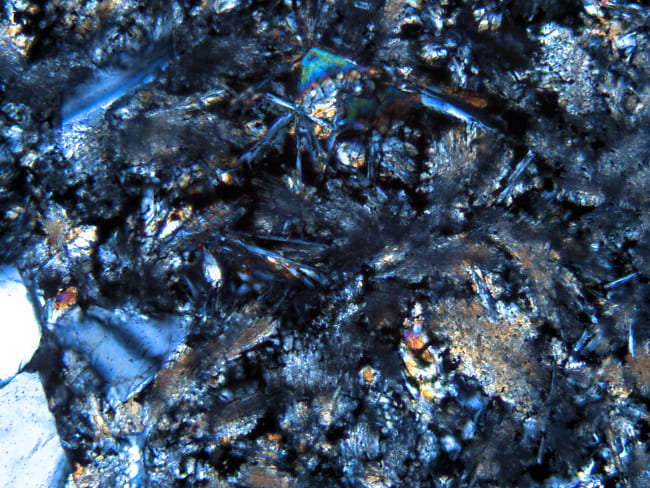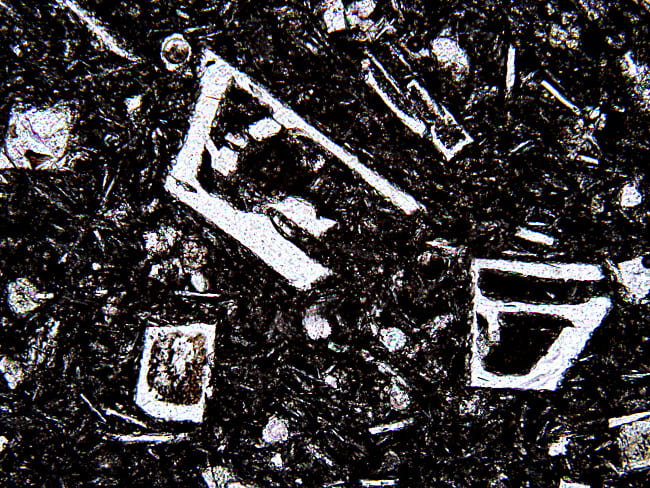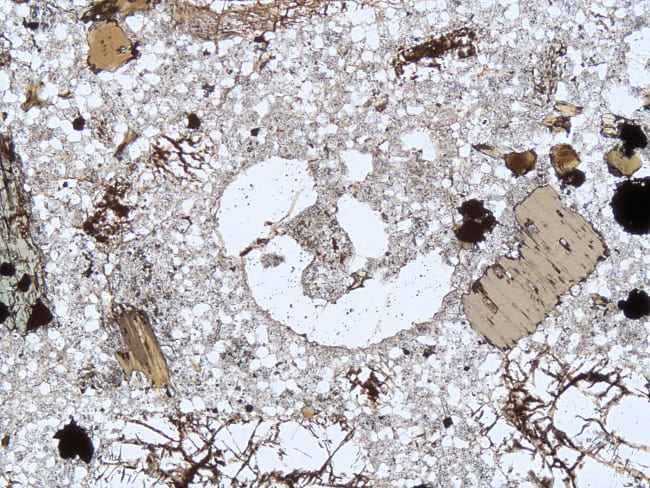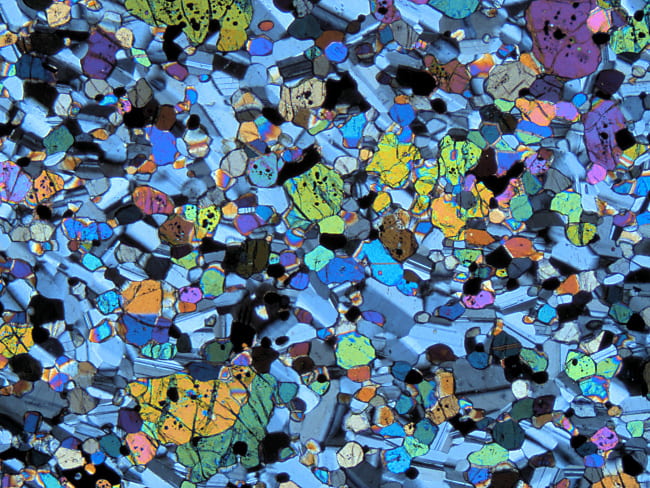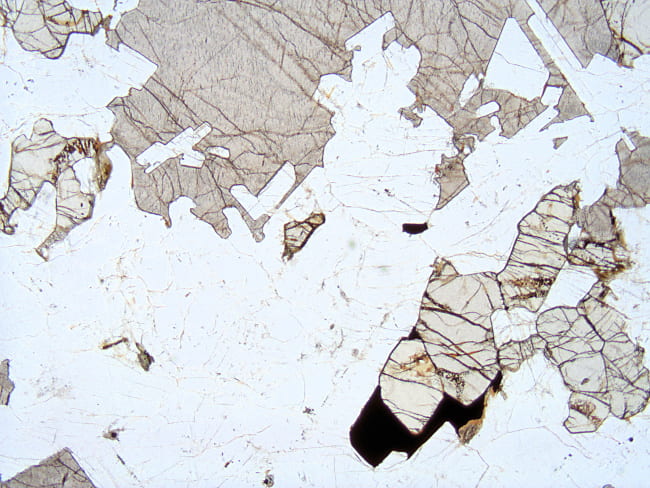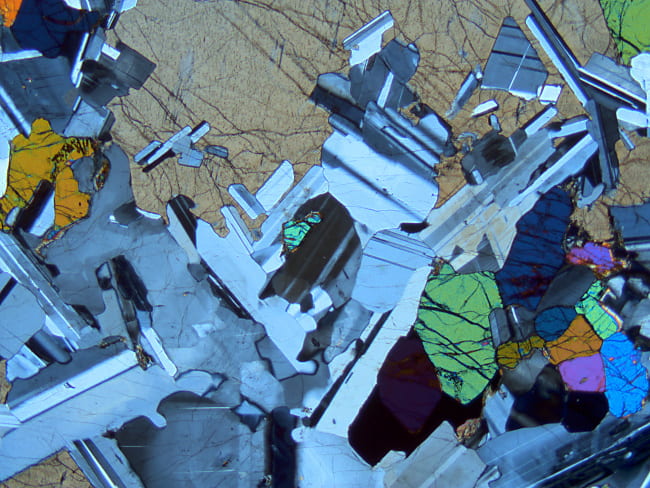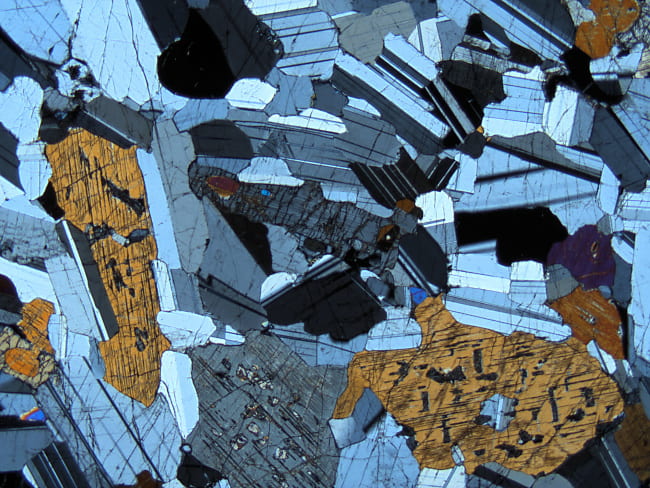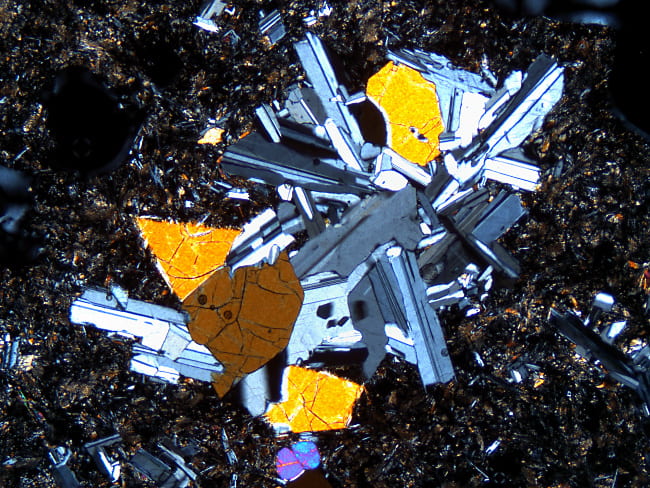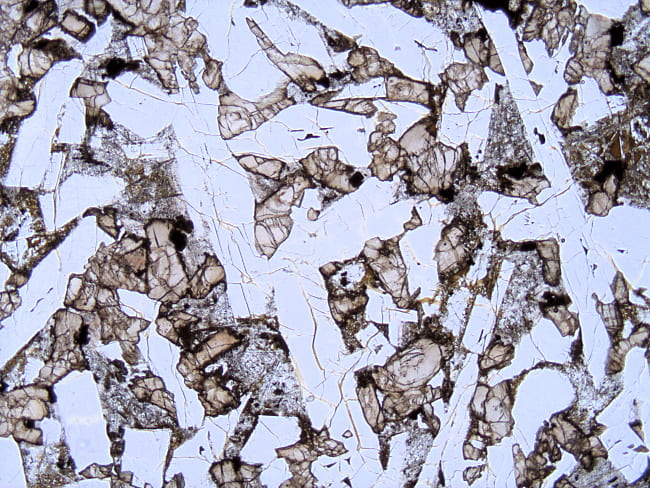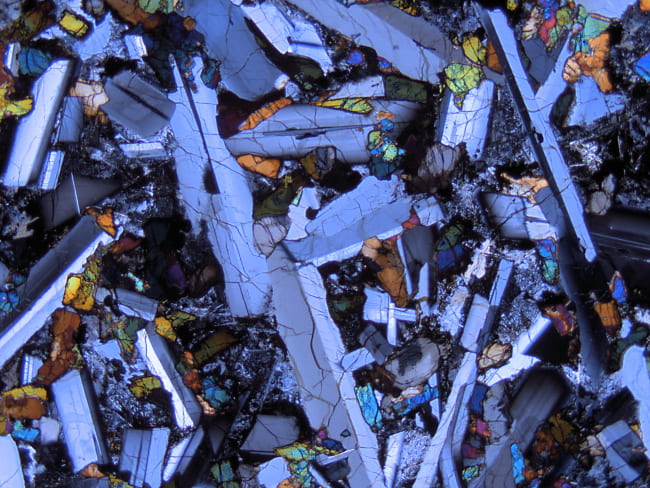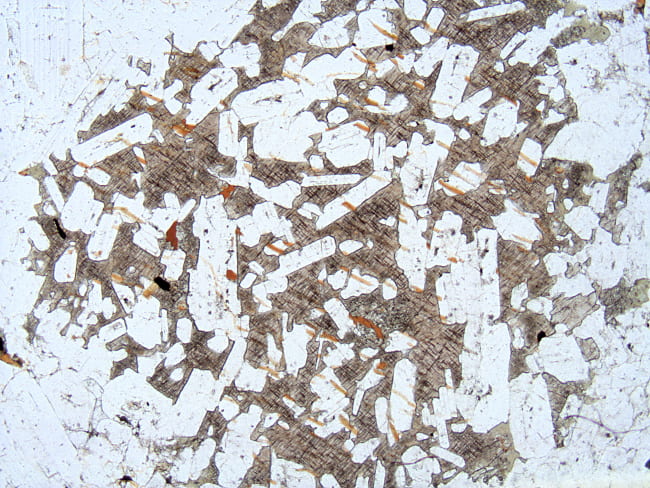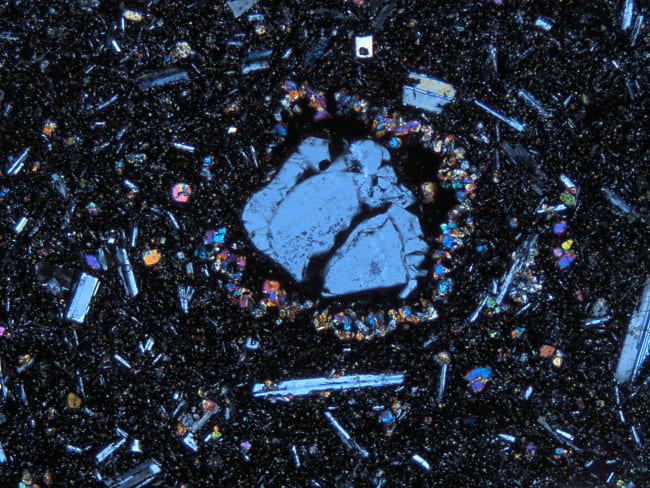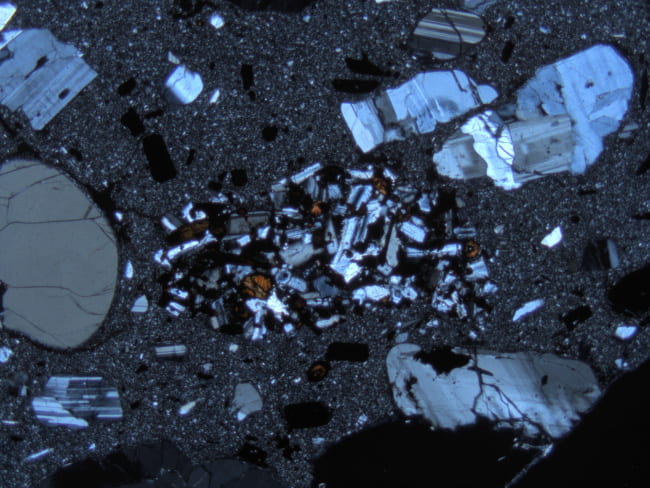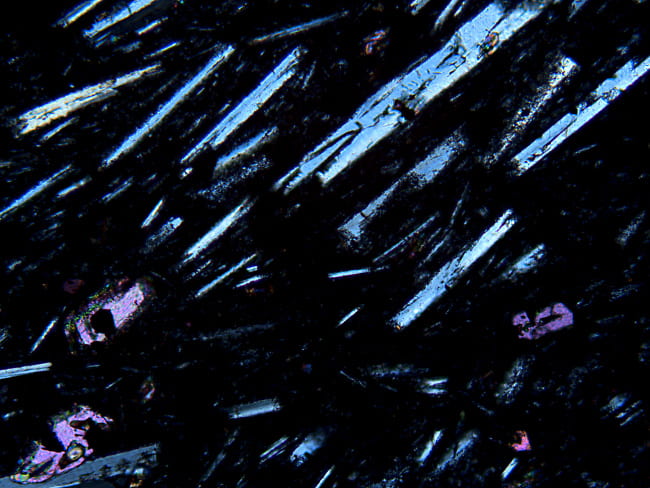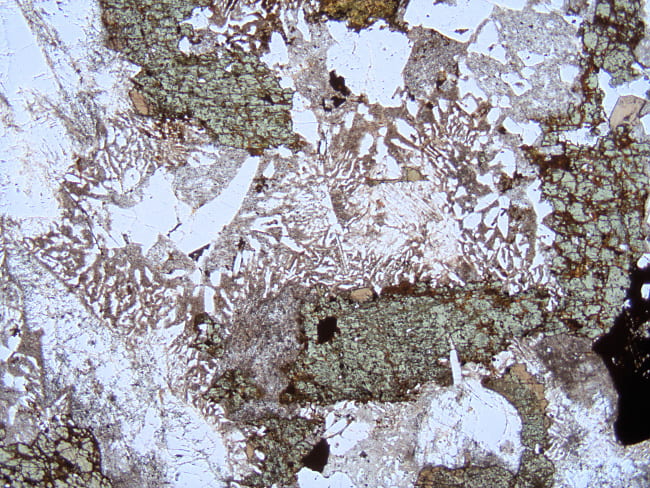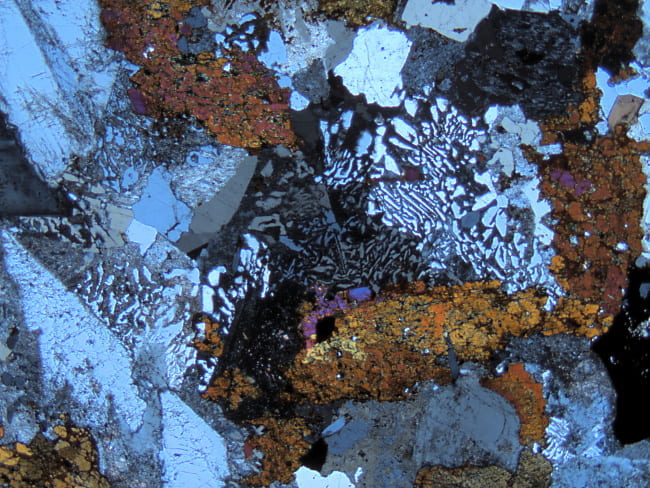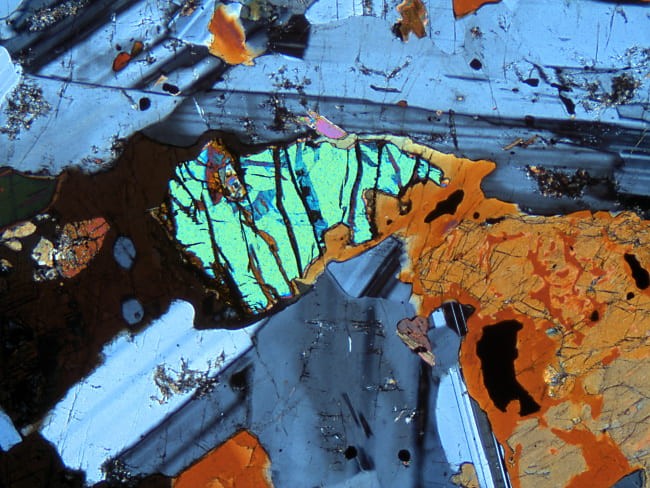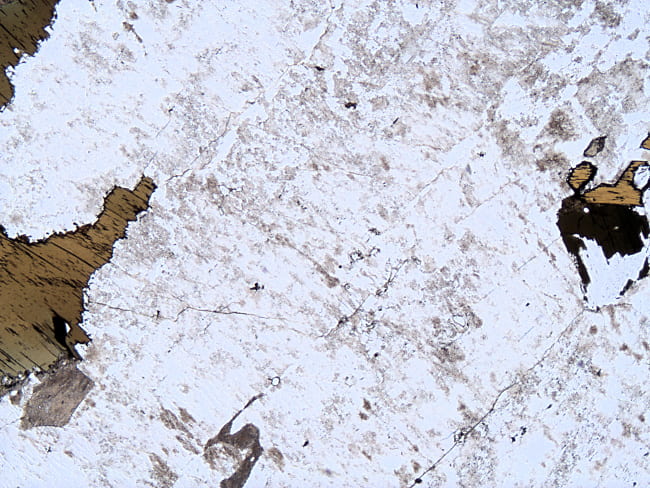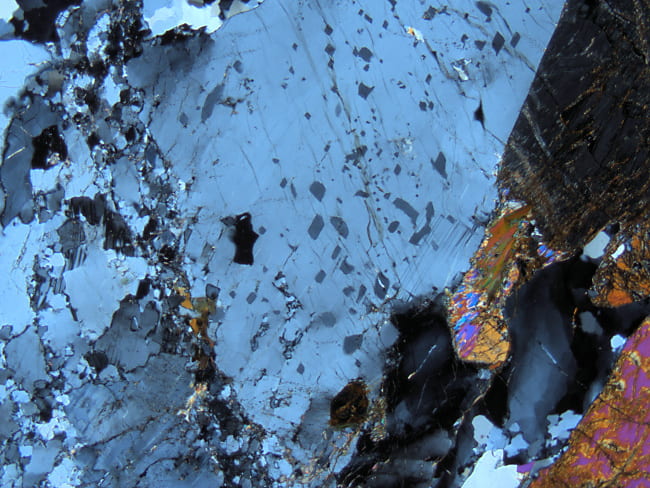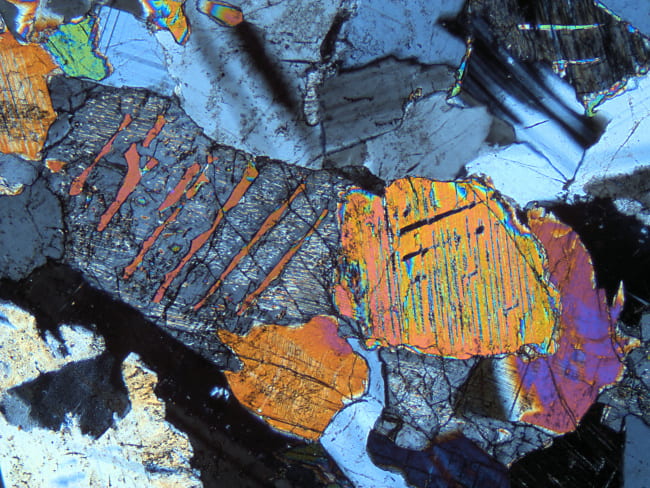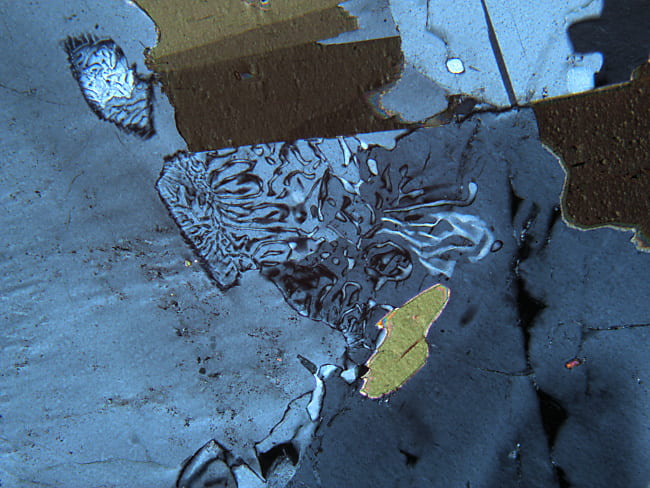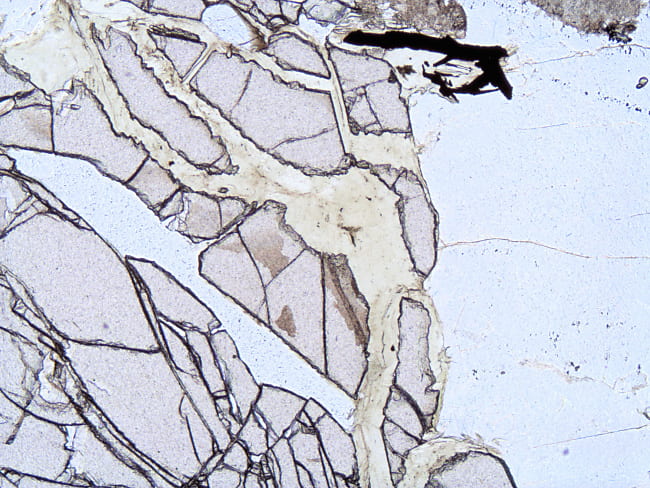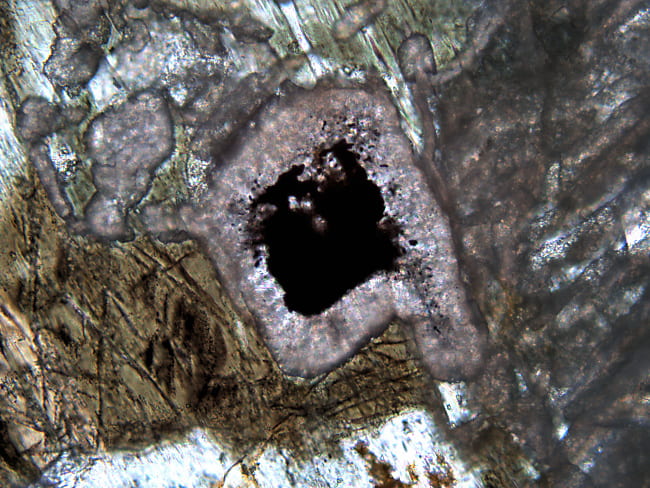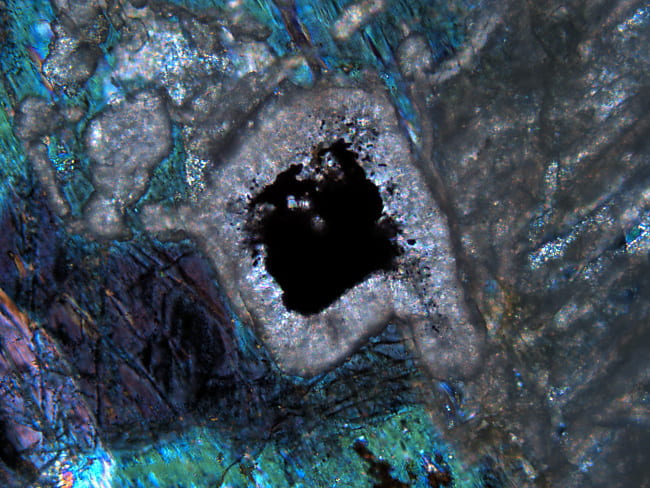Degree of crystallinity
Grain size
Bubble textures
Crystal shapes
Cumulate textures
Other primary textures
High-T reaction textures
Subsolidus unmixing textures
Subsolidus reaction textures
Degree of crystallinity
|
Glassy texture of rhyolite obsidian that has only about 2% crystals, most tiny. There are numerous tiny microlites with some flow alignment, and some small spherulites. Iceland. Plane- and cross-polarized light views. Field width is 3 mm. I-45 |
|
|
Microlites are small crystals, typically elongate, typically more or less uniform in size, and typically scattered more or less evenly through a glassy sample. Several other samples in this category have microlites, but these are big enough to be easy to see. One could call them microphenocrysts, perhaps, but their abundance and uniform size suggest that eventually they would have grown to produce a non-phenocrystic crystalline rock, had the rhyolite liquid cooled slowly enough. Iceland. Plane- and cross-polarized light views. Field width is 3 mm. ICE-22 |
|
|
Microcrystalline texture, showing relatively even grain size with a few larger mafic minerals. Though it looks entirely crystalline, about 25% glass remains in this sample. Narrow rhyolite dike, Montezuma, Colorado. Plane- and cross-polarized light views. Field width is 3 mm. 34 |
Grain size
|
Microcrystalline, <0.2 mm. Basalt with a few small olivine phenocrysts. Iceland. Plane- and cross-polarized light views. Field width is 6 mm. I-27A |
|
|
Fine-grained, 0.2-1 mm. This is an equigranular biotite-hornblende granite, with abundant quartz, plagioclase, and microperthite. Gilford, New Hampshire. Plane- and cross-polarized light views. Field width is 6 mm. 4.8.84P |
|
|
Medium-grained, 1-5 mm. This is a biotite granite, with visible quartz, plagioclase, and perthite. Halifax, Nova Scotia, Canada. Plane- and cross-polarized light views. Field width is 6 mm. NEGSA03-403-8 |
|
|
Coarse-grained, 5-15 mm. This is a somewhat altered, augite-bearing tonalite from a dike, possibly a cumulate of some sort. The igneous complex from which it is from is mostly granitic. Vinalhaven Island, Maine. Plane- and cross-polarized light views. Field width is 6 mm. VH-73 |
|
|
Equigranular biotite granite. Most grains are about the same size. Notice the allanite crystal in the upper-right. Cape Ann, Massachusetts. Plane- and cross-polarized light views. Field width is 6 mm. 4.7.84G |
|
|
Inequigranular anorthosite. Ths rock has a continuum of grain sizes, from very small to quite large. It does not have a phenocrystic texture, which would have larger crystals set in a much finer-grained matrix. This rock is a cumulate made mostly of plagioclase. In cumulates, the same minerals are typically about the same size. In this case, grain textures look somewhat annealed, possibly because of deformation and annealing when it was still very hot. Stillwater Complex, Montana. Plane- and cross-polarized light views. Field width is 6 mm. STW-37 |
|
|
Phenocrysts of olivine and augite in an otherwise microcrystalline basalt. These phenocrysts are medium-grained, and euhedral to subhedral. Iceland. Plane- and cross-polarized light views. Field width is 6 mm. I-5 |
|
|
Porphyritic texture in a trachyte. Porphyries are rocks with a large fraction of phenocrysts, typically around 50%. At this phenocryst fraction, grain-on-grain contact would make them extremely viscous. Traditionally the matrix to phenocrysts in porphyries is relatively fine-grained, suggestive of extrusive rocks or shallow levels of intrusion. Notice the strong zoning in the alkali feldspars, with orthoclase cores, a layer of lath-shaped plagioclase inclusions, and a rim of highly twinned alkali feldspar, possibly albitic. The green mafic minerals are aegirine, some of which have nearly colorless augite cores. The complex textures suggest magma mixing. Black Hills, South Dakota. Plane- and cross-polarized light views. Field width is 6 mm. Black Hills |
Bubble textures
|
Pumice, made of about 90% gas bubbles. The glass colorless to light-brown, and hard to see with all the air bubbles entrained in the epoxy mounting material (bubbles in epoxy have thin, birefringent rims). There are several phenocrysts of brown to green pyroxene, magnetite, and plagioclase. Hekla volcano, Iceland. Plane- and cross-polarized light views. Field width is 3 mm. I-50 |
|
|
Scoria. The left piece is more oxidized, and the right one relatively fresh. Both contain crystals of augite and plagioclase, in addition to about 60% vesicles. Trachyandesite, Vulsini, Valentano, Italy. Plane- and cross-polarized light views. Field width is 3 mm. RMP-16 |
|
|
Volcanic ash, with oddly-shaped, colorless glass shards that are broken pumice vesicle walls. Mixed with them is finer-grained ash, partly altered, and small crystals of biotite and feldspar. Wyoming. Plane- and cross-polarized light views. Field width is 0.6 mm. W56 |
|
|
Non-welded tuff, with several different texturally and compositionally different fragments that have different proportions of glass and crystals, set in a fine-grained ash matrix. The fragments have not been compressed, and the rock is only loosely held together. Iceland. Plane- and cross-polarized light views. Field width is 6 mm. I-X2 |
|
|
Welded tuff, with pumice fragments, glass shards, vesicles, and rock fragments variously flattened and folded. The rock is somewhat altered and oxidized. Rhyolite, Continental Divide near Estes Park, Colorado. Plane- and cross-polarized light views. Field width is 3 mm. CO88-2 |
|
|
Filled vesicles, called amygdules (amygdales in the Old World). Here the basalt originally had phenocrysts of plagioclase and numerous bubbles. Watery fluids passing through the rock altered it somewhat, and filled the vesicles first with quartz, then celadonite, and finally calcite. Vesicle fillings can include a wide array of low-temperature minerals which, besides those shown here, may include zeolites, albite, K-feldspar, epidote, clay, and others. Celadonite, by the way, is a low-temperature dioctahedral mica, approximately K(Mg,Fe2+)(Fe3+,Al)Si4O10(OH)2. Source unknown. Plane- and cross-polarized light views. Field width is 6 mm. Altered Basalt |
Crystal shapes
|
Euhedral olivine phenocryst in basalt. Euhedral crystals are entirely bounded by flat crystal faces. Basalt dike in the Skaergaard Intrusion, Greenland. Plane- and cross-polarized light views. Field width is 6 mm. Green 9 |
|
|
Subhedral crystals of plagioclase, olivine, augite, and magnetite in a cumulate gabbro. Subhedral crystals have some flat crystal faces, or shapes that approximate them. In this sample, plagioclase grains are subhedral, but olivine, augite, and magnetite are anhedral. Skaergaard intrusion, Greenland. Plane- and cross-polarized light views. Field width is 6 mm. Green 6 |
|
|
Anhedral crystals in a thin hornblende-biotite granite dike. Anhedral crystals have no flat crystal faces, and generally don’t have even the approximate shapes of a euhedral crystals. Skaergaard intrusion, Greenland. Plane- and cross-polarized light views. Field width is 6 mm. Green 8 |
|
|
Spherulites are spots where fibrous crystals radially grow from a nucleation point, usually during strong supercooling of the magmatic liquid. The radial growth causes them to characteristally have an extinction cross, typically with the N-S and E-W directions being at or close to extinction. This sample of rhyolite also has strong flow alignment of the microlites. Iceland. Plane- and cross-polarized light views. Field width is 1.2 mm. I-46 |
|
|
Radial growth of feldspar needles in obsidian. These are distinct in appearance from the brownish spherulites that occur in the same sample, shown above. Iceland. Plane- and cross-polarized light views. Field width is 0.6 mm. I-46 |
|
|
Feathery texture of pyroxene in the matrix of basalt, between glomerocrysts. The feathery texture represents rapid growth, between spherulitic and skeletal. Near the center-top there is some radial growth of plagioclase. Iceland. Plane- and cross-polarized light views. Field width is 0.6 mm I-59 |
|
|
Skeletal plagioclase phenocrysts in basalt, along with some of olivine, in a microcrystalline matrix. Skeletal growth takes place during strong supercooling, when crystals grow projections into the surrounding liquid. Iceland. Plane- and cross-polarized light views. Field width is 1.2 mm. I-30 |
|
|
Embayed or resorbed crystal of quartz in a dacite porphyry. Embayed crystals are evidence that the mineral was unstable in the magma at some point, and was dissolving away. Dissolution is faster along crystal defects, which can give such crystals odd shapes. Porphyrys are volcanic or fine-grained, hypabyssal rocks with abundant phenocrysts, typically around 50%. Continental Divide, Montezuma, Colorado. Plane- and cross-polarized light views. Field width is 3 mm. 28-Py |
|
|
Sieve texture, in microcline in rhyolite obsidian. The dark blobs that make up the sieve appearance are melt inclusions that formed during rapid, probably skeletal crystal growth. Slower growth later closed off the spaces between skeletal projections, trapping liquid. The microcline has two Carlsbad twins. There are also phenocrysts of magnetite and augite. North of Mýrdalsjökul, Iceland. Plane- and cross-polarized light views. Field width is 3 mm. ICE-21 |
|
|
Annealed or recrystallized texture, in this case basalt that was held at high temperature for a long period of time. The original grains have recrystallized into approximately equant, anhedral grains of colorless plagiocase, colorless, high-index olivine, pale brown augite, and black magnetite. Grain intersection angles are typically near 120° angles. Xenolith in the Skaergaard Intrusion, Greenland. Plane- and cross-polarized light views. Field width is 1.2 mm. Green 40 |
Cumulate textures
|
Orthocumulate texture, with cumulate plagioclase and olivine crystals enclosing quenched basaltic liquid. If this were more slowly-cooled, the trapped liquid pockets would have crystallized into overgrowths on adjacent plagioclase and olivine, plus a few grains of magnetite, augite, apatite, and other interstitial phases. Iceland. Plane- and cross-polarized light views. Field width is 6 mm. I-27B |
|
|
Mesocumulate texture, in which liquid trapped between cumulate crystals was able to exchange material with the nearby magma, allowing more extensive overgrowths of cumulate minerals and a smaller volume of ultimately trapped liquid. Small grains of olivine, pyroxene, magnetite, and apatite indicate the original trapped liquid. Skaergaard Intrusion, Greenland. Plane- and cross-polarized light views. Field width is 6 mm. Green 14 |
|
|
Adcumulate texture, where essentially all trapped liquid was able to exchange material with the nearby magma, allowing overgrowths to fill the trapped liquid pockets. This results in a rock almost completley made of the cumulate minerals, and so very simple mineralogy. Here the cumulate minerals were plagioclase and orthopyroxene. Stillwater Complex, Montana. Plane- and cross-polarized light views. Field width is 6 mm. STW-33 |
Other igneous textures
|
Glomerocryst made of plagioclase and olivine in basalt. Glomerocrysts are clumps of large crystals set in a fine-grained matrix, a variety of phenocrystic texture. Glomerocrysts probably result in nucleation of new crystals taking place on or very near the surfaces of crystals already present. Iceland. Plane- and cross-polarized light views. Field width is 3 mm. I-59 |
|
|
Ophitic texture, in which large pyroxene crystals enclose randomly-oriented plagioclase, and commonly other minerals. This texture forms where there are few pyroxene nuclei, so those few grow quite large, enclosing the other minerals. This example, from the marginal border series of the intrusion, has augite enclosing plagioclase and olivine. Skaergaard Intrusion, Greenland. Plane- and cross-polarized light views. Field width is 3 mm. Green 24 |
|
|
Subophitic texture, in which randomly-oriented plagioclase crystals touch one another, generally enclosing pyroxenes and other minerals. This diabase from a thick lava flow contains abundant interstitial granitoid material, brown, isotropic altered glass, skeletal magnetite, and other interesting features. East Granby, Connecticut. Plane- and cross-polarized light views. Field width is 3 mm. NEGSA95-C1-1 |
|
|
Poikilitic texture, in which one large crystal encloses many smaller crystals. It is similar to ophitic textures, but the enclosing mineral need not be pyroxene. Greenville, Maine. Plane- and cross-polarized light views. Field width is 6 mm. NEIGC83-C1-8 |
|
|
Chilled margin from a pillow lava rim. The pillow margin quenched to glass, enclosing euhedral phenocrysts. The more slowly-cooled interior first grew spherulites, which increase in abundance and size inward, coalescing into a solid mass of them on the right side of this image. Farther in, sizable crystals grew in the matrix to give more typical basaltic textures. Iceland. Plane- and cross-polarized light views. Field width is 6 mm. ICE-24A |
|
|
Xenocryst in basalt. In general, it’s difficult to tell xenocrysts from phenocrysts, if they are the same mineral, just by looking at them. In this case, the olivine basalt has xenocrysts of quartz, which could not have crystallized from this magma. The quartz grains reacted with the magma to form a garland of small augite crystals. You can actually get a uniaxial positive interference figure from this quartz grain. Iceland. Plane- and cross-polarized light views. Field width is 3 mm. I-12 |
|
|
Xenolith in rhyolite. Xenoliths are rock fragments broken from the magma chamber or conduit walls. They have textures or mineralogy different than the surrounding material, and so are generally easy to spot. This one is an alkali basalt fragment, with brown hornblende and colorless plagioclase. Much of the hornblende is nearly black because of oxidation at the time of eruption. Unknown source. Plane- and cross-polarized light views. Field width is 6 mm. Rhyolite-2 |
|
|
Flow-aligned plagioclase crystals in an olivine basalt. Flow alignment can occur in any magma type or grain size, representing differential (shear) flow probably close to the time of solidification. Iceland. Plane- and cross-polarized light views. Field width is 1.2 mm. I-25 |
|
|
Granophyre in a highly fractionally crystallized gabbro. Granophyre, or ‘graphic granite,’ is an ordered intergrowth of quartz and alkali feldspar. In some cases these are found in pegmatites and other felsic rocks, but the textures are also found in mafic rocks as the last bit of evolved, felsic liquid crystallizes. Here, the granophyre formed in the last bit of interstitial liquid, among cumulate olivine (fayalite), plagiocalse, magnetite, apatite, brownish magmatic augite, and, shown here, green augite that is inverted ferrobustamite. Skaergaard Intrusion, Greenland. Plane- and cross-polarized light views. Field width is 6 mm. Green 29 |
High-T reaction textures
|
Hornblende rimming quartz. This shows a quartz-rich xenolith enclosed in a granitic porphyry. At the time the xenolith became trapped, the magma was undersaturated with respect to quartz. The quartz reacted with the magma to grow a rim of hornblende. Later, the magma became quartz-saturated and grew quartz and hornblende as distinct, separated crystals. This is similar to the augite-rimmed quartz xenolith, shown above. Laconia, New Hampshire. Plane- and cross-polarized light views. Field width is 6 mm. 4-8-84K |
|
|
Hornblende replacing olivine and augite. This is an alkaline olivine gabbro. The primary magmatic minerals include plagioclase, olivine, augite, biotite, magnetite, and late brown hornblende. Probably very close to solidus temperatures olivine and augite reacted with the hydrous residual liquid to grow hornblende rims on both olivine, augite, and magnetite. Imperfections in the augite, possibly trapped liquid inclusions or exsolution lamellae, also reacted to grow hornblende within augite crystals. Note that the hornblende rims are brown on augite and magnetite, and green on parts of the olivine. The green hornblende is low in titanium, contrasting with the brown high-titanium hornblende. Salem, Massachusetts. Plane- and cross-polarized light views. Field width is 3 mm. 4.7.84E |
Subsolidus unmixing textures
|
Perthite exsolution texture, with irregular albite exsolution lamellae in microcline host crystals. This represents subsolidus unmixing of an originally homogeous K-Na feldspar solid solution. Vinalhaven Island, Maine. Plane- and cross-polarized light views. Field width is 6 mm. VH1 |
|
|
Mesoperthite exsolution texture, in which an intermediate K-Na feldspar has exsolved to approximately equal proportions of albite and K-feldspar. In this case, the rock is a cumulate syenite, with large, slab-shaped cumulate feldspars. Red Hill, Center Harbor, New Hampshire. Plane- and cross-polarized light views. Field width is 3 mm. RH-4 |
|
|
Antiperthite exsolution texture, in which K-feldspar has unmixed from a plagioclase host. In this case the rock is a somewhat deformed diorite, and the exsolved K-feldspar lamellae have annealed somewhat into angular shapes. Union, Connecticut. Plane- and cross-polarized light views. Field width is 6 mm. WL-H36A |
|
|
Pyroxene exsolution textures. This rock is a gabbro which originally had crystals of homogeneous pigeonite and augite. The augite, represented by the pinkish-yellow grain to the right, has pigeonite exsolution lamellae. The original pigeonite, represented by the large gray grain to the left, exsolved augite lamellae, and then inverted to orthopyroxene. Remember that orthopyroxene has much lower birefringence than augite. Unknown source. Plane- and cross-polarized light views. Field width is 3 mm. Un5 |
Subsolidus reaction textures
|
Myrmekite. Myrmekite is a wormy intergrowth of quartz and feldspar, generally forming as a subsolidus reaction product of feldspar and migrating fluids. Continental Divide near Estes Park, Colorado. Plane- and cross-polarized light views. Field width is 1.2 mm. CO88-1 |
|
|
Chlorite replacing garnet. On the left is a magmatic garnet in a peraluminous granite. It was fractured, and aqueous fluid caused it to react to form chlorite. The chlorite is pale-green in plane light, with low first-order anomalous Berlin blue interference colors. Kinsman Granite, New Hampshire. Plane- and cross-polarized light views. Field width is 3 mm. NHM-21 |
|
|
TiO2 replacing ilmenite in a highly altered gabbro. The original gabbro probably was made of plagioclase, augite, magnetite, and ilmenite, among other things. Alteration without deformation changed this assemblage to one largely made of actinolite, hornblende, chlorite, and sericite. As ilmenite broke down, the TiO2 in its structure precipitated in-place to partially pseudomorph the original ilmenite. Such fine-grained TiO2 is sometimes called leucoxene. The TiO2 polymorph is commonly anatase. Northwestern New Hampshire. Plane- and cross-polarized light views. Field width is 0.6 mm. NNH-7 |
